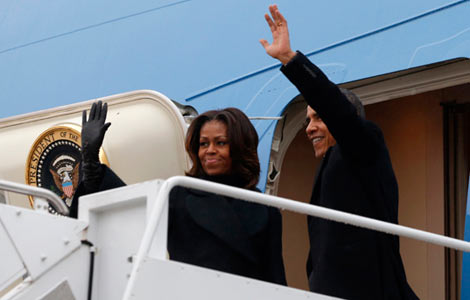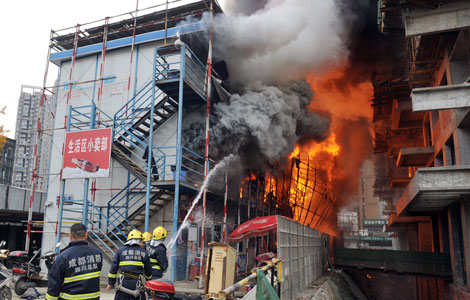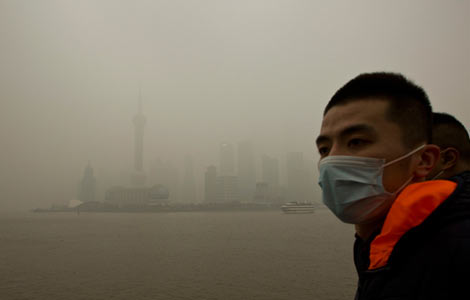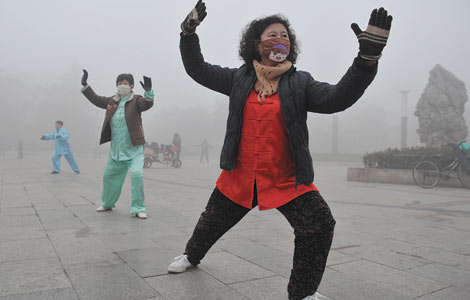Gallup poll a bit hazy over air quality satisfaction
Updated: 2013-11-26 08:21
By Chen Weihua (China Daily USA)
|
||||||||
 The latest Gallup poll of people's satisfaction with air quality in the area where they live seems to defy the realities on the ground in China.
The latest Gallup poll of people's satisfaction with air quality in the area where they live seems to defy the realities on the ground in China.
Nearly four in five adults (78 percent) worldwide in 2012 said they were content with air quality where they live, which is in line with what Gallup has measured since 2008, according to the report released Friday.
Asia (81 percent) and Europe (79 percent) led the overall satisfaction with air quality, while people in the Middle East and North Africa (66 percent) and the former Soviet Union countries (60 percent) rated their air the worst.
However, Hong Kong residents, with a satisfact
ion rate of 34 percent, remained the least content in the world for the second year in a row.
By contrast, a majority (77 percent) on the Chinese mainland were satisfied with air quality, compared with 84 percent in India and 68 percent in Brazil, two other large emerging economies.
The report attributes Hong Kong residents' dissatisfaction to living in one of the most densely populated areas in the world, high traffic volume, a preponderance of coal-fired power stations and being next door to one of China's industrial heartlands.
This could all be true, but compared with many Chinese mainland cities — especially cities in its border province Guangdong — Hong Kong's air quality has been much better, according to various studies.
A study released in March by Canton Public Opinion Research Center based in Guangzhou, Guangdong province, found that 48 percent of the 2,000 people interviewed described the air quality as "worsening", while only 16 percent said it's improving. It also cited the dissatisfaction rate as jumping 11 percent this year to 37 percent.
Nationwide, deteriorating air quality has become a top concern for both average Chinese and government leaders.
Just as Chinese tourists flocking to the US on China's National Day holiday week in early October were frustrated with the closure of museums and national parks due to the partial federal government shutdown, many vacationers flooding domestic tourist attractions found themselves surrounded by thick smog in East and North China, especially in areas around Beijing.
The choking pollution was so bad in some areas that it went beyond the measuring capacity of air quality meters.
This past weekend, the smog in parts of northeast China caused the airport in Harbin, Heilongjiang province, to cancel 209 inbound and outbound flights on Saturday. Some highways in the area were also closed as visibility dropped to less than 50 meters, or 164 feet. Schools were suspended.
News about smog and haze has increasingly dominated headlines in China. Early this month, the Ministry of Environmental Protection advised that large outdoor events should be halted, schools and kindergartens suspended and institutions and businesses should adopt flexible working hours on days when warnings of the highest degrees of air pollution are issued.
It is common now to see people wearing face masks in cities like Beijing or Shanghai to guard against air pollution, particularly car exhaust. Some mask-makers are touting how their products can effectively filter out particulate matter as small as PM2.5, the fine particles only 2.5 micrometers in size that can penetrate deepest into the lungs and were not measured in most Chinese cities until last year.
Meanwhile, traffic departments are busy advising people on how to drive safely during low-visibility days shrouded in smog or haze.

 World Cup mascot makes China debut
World Cup mascot makes China debut
 Catering to Chinese viewers a hurdle for Hollywood
Catering to Chinese viewers a hurdle for Hollywood
 World's top leaders pay tribute to Mandela
World's top leaders pay tribute to Mandela
 Art students take protest to the mall
Art students take protest to the mall
 German DHL testing delivery drones
German DHL testing delivery drones
 Fire breaks out at construction site in SW China
Fire breaks out at construction site in SW China
 More emission controls urged
More emission controls urged
 DPRK leader's uncle stripped of all posts
DPRK leader's uncle stripped of all posts
Most Viewed
Editor's Picks

|

|

|

|

|

|
Today's Top News
John Kerry to visit Mideast, Vietnam, Philippines
Obama, Bush embark for Mandela memorial
Girl's death spark calls for child services oversight
US urged to change surveillance laws
Japan 'betrays' arms embargo
China opens key economic meeting
Water diversion set to benefit Shandong
GDP growth could hit 7.8% next year
US Weekly

|

|






